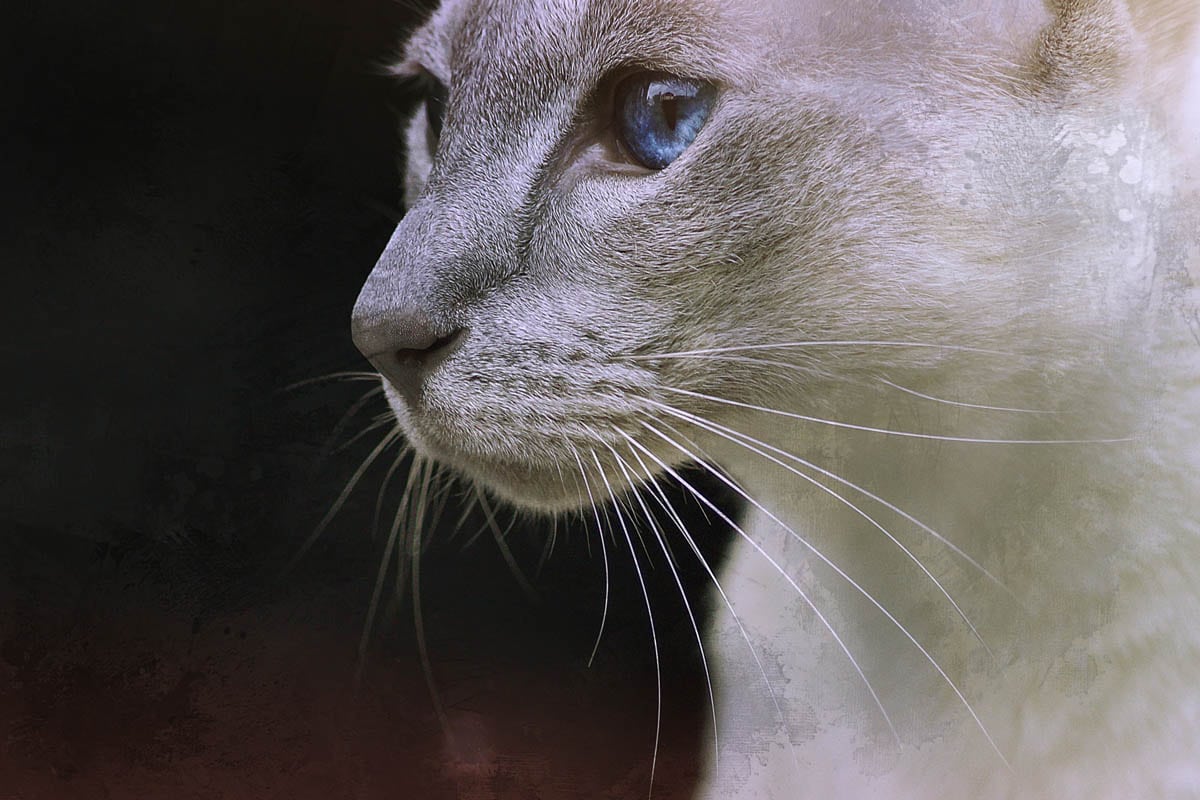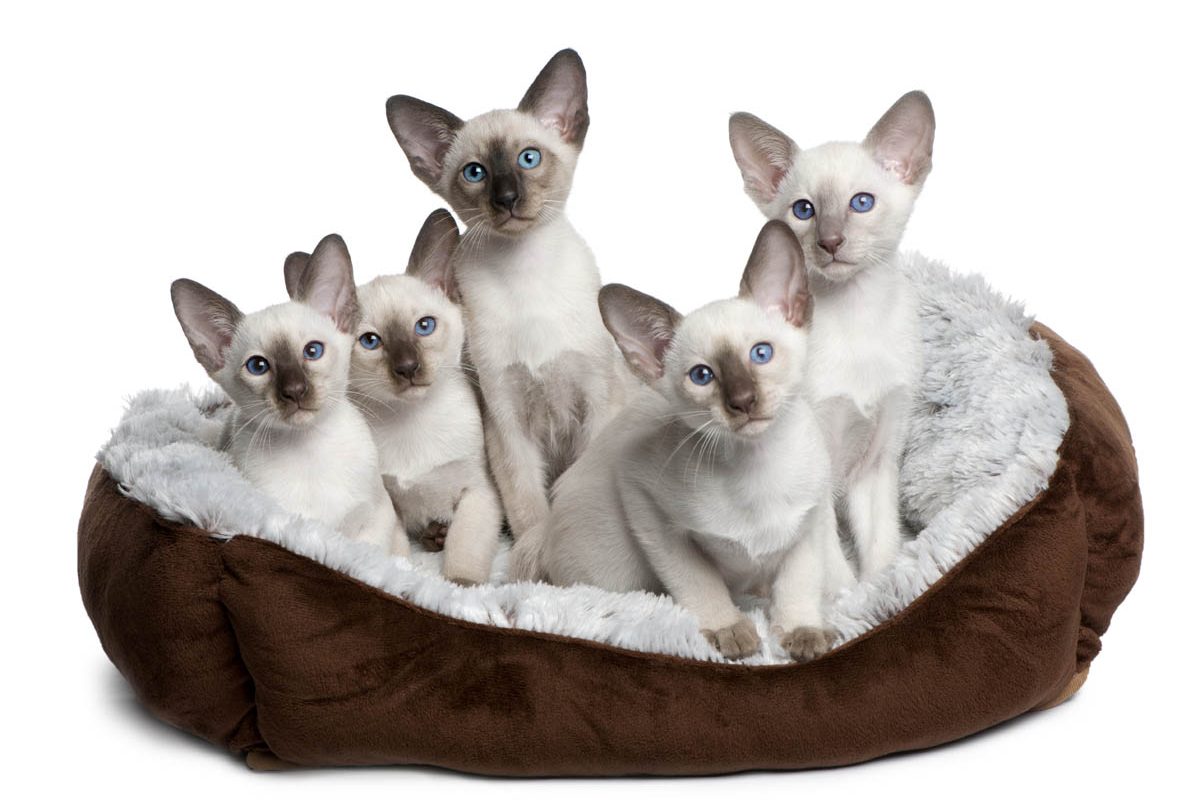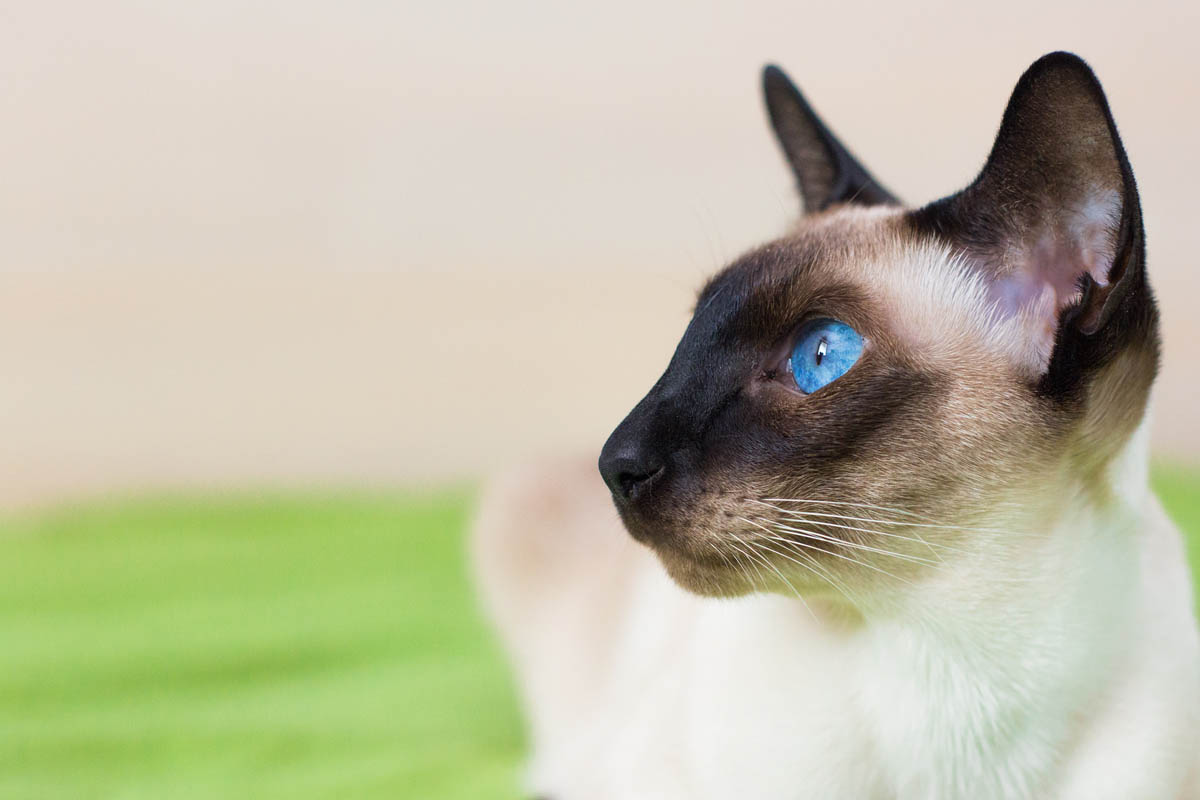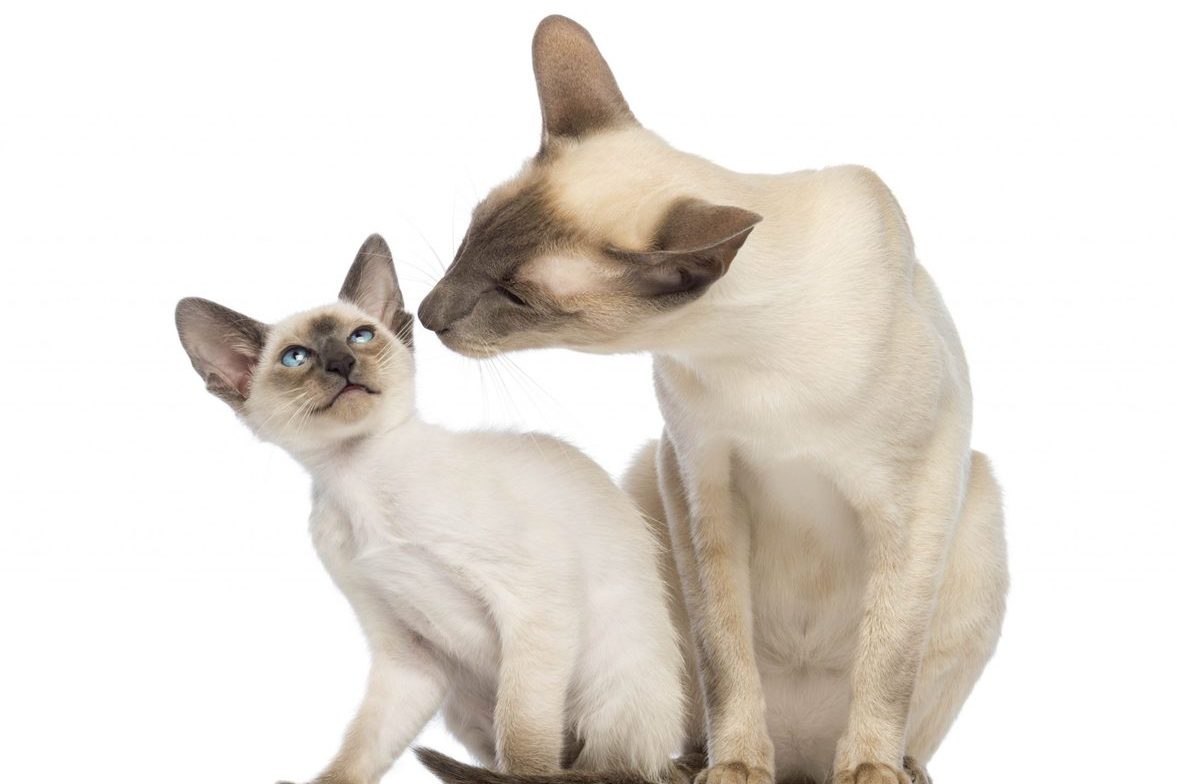At a glance
|
About

Possibly the most instantly recognisable of all cat breeds, the Siamese cat is an ancient breed of cat with a colourful history and many legends surrounding it.
One legend is that Siamese cats guarded the Buddhist temples and were considered sacred. According to Sally Franklin in her book The Complete Siamese Cat, when a high-ranking person died, a Siamese was chosen to receive the dead person’s soul. The cat was removed from the royal household and sent to one of the temples to spend the rest of its days living a ceremonial life of great luxury, with monks and priests as his servants. [2]
The Siamese is a stunning blue-eyed cat with dark points on the face, ears legs and tail, on a light body. Their unusual colouring is a form of partial albinism.
Related: Siamese cat genetics
History
The history of the Siamese isn’t entirely known, although there are plenty of theories as to its origins.
- Sydney W. France, in his book ‘Siamese Cats‘ claims that the Hon. Russell Gordon gave his considered opinion that the Siamese cat was a cross between the Sacred Cat of Burma and the Annamite cat introduced into the religiously sealed and guarded Burmese Temples, which were imported into Siam when the Cambodian Empire of Khmer fell to the attacks of the Siamese.
- German explorer and zoologist Peter Simon Pallas shows a picture of a cat seen in the area of the Caspian Sea with a Siamese coat pattern which was said to be the progeny of a black cat and had a chestnut-brown body, black at the back and paler along the sides and belly, with a black streak running along and surrounding the eyes. [1]
Arrival in England:
The first cat show was held at Crystal Palace, London in July 1871, which included two Siamese cats owned by Mr Maxwell. One journalist describes them as “…soft, fawn-coloured creatures, with jet-black legs – an unnatural, nightmare kind of cat, singular and elegant in their smooth skins, and ears tipped with black, and blue eyes with red pupils.” There is little information on Mr Maxwell or the origins of these Siamese cats.

In 1884 Mr Edward Blencowe Gould an Acting Vice-Consul at Bangkok obtained a breeding pair of Siamese cats called Pho and Mia. It is said that King Chulalongkorn gave them to him, although this story does attract some scepticism. What we do know is that two Siamese cats arrived in England from Bangkok by Mr Gould as a present to his sister, Mrs Lilian Veley. Pho and Mia are recorded as 1a and 2a in the Siamese Cat Register. Mrs Veley went on to co-found the Siamese Cat Club in 1901.
The following year, Mrs Vyvyan and her sister of Dover imported two Siamese cats. Mrs Vyvyan writes to Harrison Weir ‘The original pair were sent from Bangkok, and it is believed that they came from the King’s Palace, where alone the breed is said to be kept pure. At any rate, they were procured as a great favour, after much delay and great difficulty, and since that time no others have been attainable by the same person. We were in China when they reached us, and the following year, 1886, we brought the father, mother and a pair of kittens to England.’
During the next few years, more Siamese cats were imported into Britain and are the foundation cats of the Siamese we know and love now.
Temperament
The Siamese is an extremely intelligent, loyal and affectionate cat who forms close bonds with its human family. They are often described as ‘dog-like‘ in that they enjoy playing fetch.
Siamese cats need to be with their human companions almost constantly and do not do well on their own. They often form a close bond with one particular member of the household, sometimes at the exclusion of others.
One of the most talkative cat breeds, the Siamese love to give their human companions a running commentary with their unique, deep and loud meow.
Appearance
Body: The Siamese is a medium-sized, elegant animal with a long, muscular and tubular body and a long neck. Legs are long and slender with small, oval feet. Hind legs are longer than the front legs. The tail is long, thin and whip-like.
Head: The head is a long, tapering wedge that flares out in a straight line to the tip of the large ears. The nose is long and straight with no break. Eyes are almond-shaped, and slant towards the nose. All Siamese have blue eyes.
Coat: The Siamese coat pattern is striking. The face, paws, ears, and tail (points) have a darker colouring; the body is light in colour. The coat should be short, fine and silky to the touch.
Three types of Siamese cat

The changing appearance of Siamese cats
Siamese cats have changed quite a lot in the past three decades and have become much more slender than their ancestors. Originally there were two Siamese types, the applehead and the classic. The classic Siamese is more somewhere between the applehead and modern but has been around as long as Siamese have. Over time, the Siamese body and head became more slender (wedge-shaped).
Below is a photo of our tabby point Siamese from the late 1970s. You can see their face shape is different to the modern Siamese of today.

Some breeders continue to breed the old-style Siamese under the name Traditional, Thai, Applehead or Old Style Siamese. But cats on the show bench are usually fit the ‘modern’ standard, pet Siamese may be less slender in the face.
Siamese cat colours
Original colours:
- Seal
- Blue
- Chocolate
- Lilac
The Cat Fanciers Association only accepts the traditional colours listed above, and other colours go under the classification of colourpoint shorthair.
Other cat associations accept different Siamese colours in addition to seal, blue, chocolate and lilac, which include:
- Red (flame)
- Cream
- Fawn
- Caramel
- Apricot
- Cinnamon
These colours can also occur in tabby point (also known as lynx) and tortie point.
Choosing a Siamese cat
Siamese should be bought from a registered cat breeder to ensure you are getting what you are paying for. Registered breeders have to abide by a code of ethics set out by their registering body. I always prefer to buy purebred cats from a breeder who raises the kittens underfoot, which means they grew up inside the home and are used to the hustle and bustle of a household.
Where possible, visit the cattery and meet the kittens and parents.
Kittens should not leave the breeder until they are at least 12 weeks old, by which time they will have received at least two of the required three F3 vaccinations. Some breeders also choose to desex (spay or neuter) their kittens before they go to their new homes. All cats sold or given away in New South Wales must be microchipped.
Write a list of questions for the breeder before you visit the cattery and always get guarantees in writing. If you pay cash (and I don’t recommend it), insist on a receipt.
Care
The Siamese cat’s coat is low maintenance, groom once a week to remove loose hairs. Trim the claws every 4-6 weeks.
Dental care is essential for all cats. Your Siamese should have his teeth brushed regularly with a cat toothbrush and toothpaste (never use human toothpaste on a cat). Or you can feed him raw chicken necks or human-grade chunks of beef two to three times a week.
Do not let your Siamese cat roam free; there are too many dangers out there. If possible, give him access to a cat enclosure that keeps him safe, but allows him to enjoy the outdoors.
Feed a good quality diet, preferably wet. Find out what the breeder has been feeding him and give him the same, if you would prefer to feed him something different, slowly introduce the new food while feeding less of the old.
Health
All cats, purebred or mixed breed can be prone to specific health problems, Siamese may have a higher incidence of the following:
- Convergent strabismus (cross eyes): A cosmetic-only condition due to the effects of the Himalayan gene which gives the Siamese cat its unique appearance also involves the eyes. The eyes of cats with strabismus do not line up with each other, instead of facing forward, the eyes turn inward (exotropia) due to abnormal wiring between the eyes and the brain.
- Kinked tail (cosmetic only): Some Siamese (and Burmese) will have a slight kink or bend in the last bone of the tail. There is scant information on this, but tail ‘abnormalities’ are commonly seen in Asian cats and are presumably inherited.
- Hemophilia B: Factor IX deficiency: An inherited bleeding disorder in which the blood doesn’t clot properly due to a lack of clotting proteins (coagulation factors).
- Familial amyloidosis: A build-up of amyloid proteins in the heart, kidneys, liver or other organs. Amyloid is an abnormally folded protein produced in the bone marrow and deposited in tissues or organs causing damage by displacing normal cells. The liver is typically affected in Siamese cats.
- Systemic lupus erythematosus: An inflammatory disease that is caused by the cat’s own immune system attacking the tissues when the body produces antibodies against itself (known as auto-antibodies), attacking various systems including the skin, joints, blood vessels, kidneys, heart, and lungs. There is a higher incidence of SLE in Siamese, Persian and Persian related breeds.
- Feline hyperesthesia syndrome: A condition characterised by unusual behaviour which may include: rippling skin along the back, sudden bouts of frantic biting and licking at the tail, pelvis or flank, eyes wide open, dilated pupils and aggression. During an attack, your cat will behave as if he is reacting to hallucinatory stimuli.
- Pica and wool sucking: A potentially serious condition where they have an abnormal compulsion to eat non-food substances such as clothing, plastic, wool etc. The preferred food choice is generally reserved for the same object.
- Mammary (breast) cancer: The third most common tumour in the cat. 85-95% of mammary gland tumours are malignant, and adenocarcinomas are the most common type of malignant neoplasm of mammary gland cancer. Siamese cats have twice the risk of developing mammary cancer than all other breeds combined.
- Mast cell tumour: Skin tumours that have arisen from mast cells, which are a type of white blood cell formed in the bone marrow. These cells are found throughout the body but concentrate at points of contact between the cat and the outside world, especially the skin, respiratory tract, gastrointestinal tract, and conjunctiva.
- Progressive retinal atrophy: A disease that results in the degeneration and atrophy of the retina, which is made of photosensitive cells known as rods and cones which convert light into electrical impulses and transport them to the brain via the optic nerve. The disease is caused by a mutation of the CEP290 gene, which encodes for the centrosomal protein 290 kDa which maintains the important structure known as the cilium in rod photoreceptors.
Breeders have worked hard to eliminate inherited diseases in Siamese cats, and early spaying greatly reduces the risk of mammary cancer. Strabismus and kinked tails have largely been bred out.
Who are Siamese cats suited to?
The Siamese cat thrives on attention and needs to be a part of the family. They are very dog-like and like to be a part of what you are doing. Siamese cats do not do well if ignored or left for extended periods on their own.
A Siamese will often form a strong bond with one member of the household, and can sometimes become quite jealous. If you want a constant companion who will follow you around, conversing with you, then the Siamese is for you. If you prefer a quieter and more hands-off cat, then another breed may be more suitable. Siamese cats do like to be the king or queen of their domain.
Siamese cat FAQ
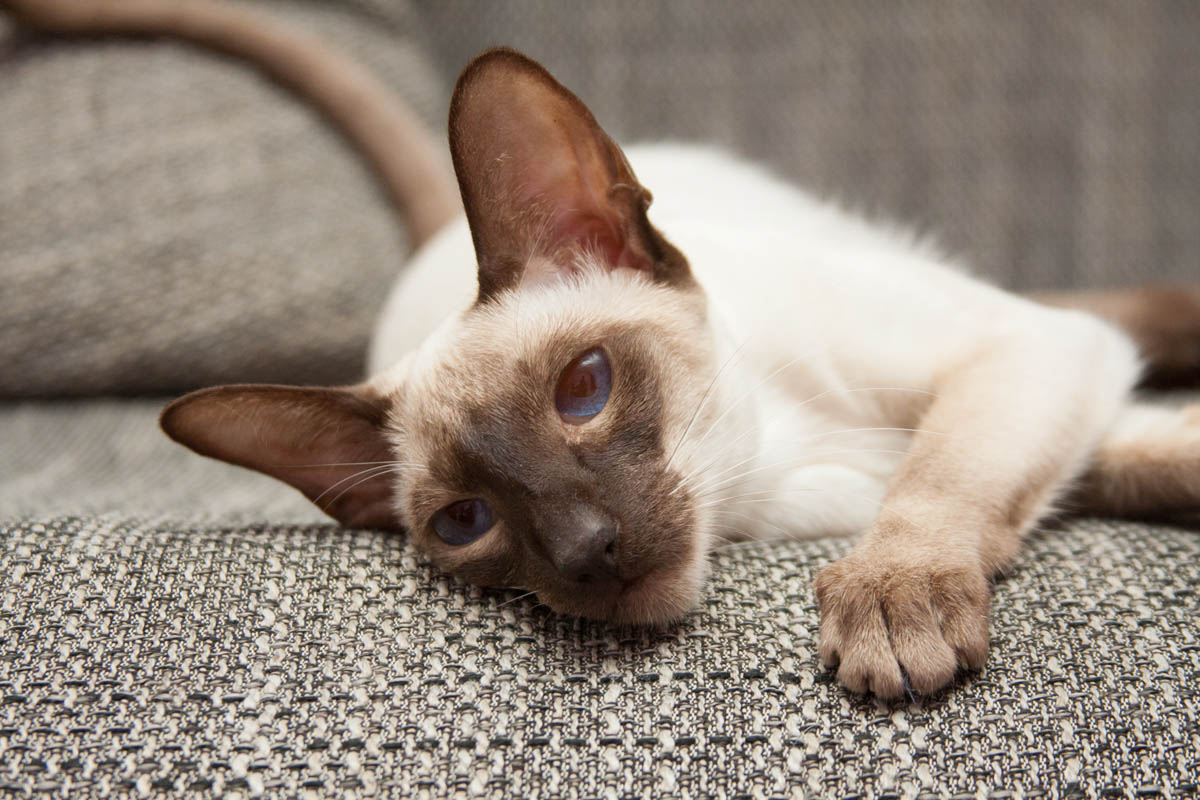
Do Siamese cats shed a lot?
All cats shed, the Siamese sheds less than other breeds.
Why are Siamese cats called Siamese?
Siamese cats originated from Thailand, which was formerly known as Siam.
Are Siamese cats jealous?
Siamese cats typically bond with one person in the family and display jealousy towards other family members.
Are Siamese cats smart?
Siamese cats are one of the most intelligent cat breeds.
Is there a hairless Siamese cat?

The Peterbald is a cross between an oriental shorthair (a cat with the Siamese body type but non-pointed) and a Don sphynx. The Peterbald occurs in all colours, including pointed.
Are Siamese cats high-maintenance?
As far as physical care, the Siamese is no more high maintenance than any other shorthaired breed. A weekly brush is enough to remove loose hairs as well as provide adequate dental care.
The Siamese forms close bonds with their human family, which includes plenty of human interaction and do have higher emotional needs than other breeds.
Siamese cats are extremely vocal and will share their opinion with their human family if it is asked for or not. Most people who choose a Siamese do so knowing that they are adopting a talkative cat.
What is the best food for a Siamese cat?
Once the Siamese kitten has weaned, feed a premium kitten food until adulthood and switch to a premium adult maintenance diet which can include both canned and dry food.
Why do Siamese cats have dark points?
Genetically a Seal Point Siamese cat is a black cat; however, Siamese cats carry the Himalayan gene (known as cs) which has a temperature-sensitive expression. This gene causes partial albinism due to a defective enzyme tyrosinase and is located in the melanocytes which are responsible for controlling the production of melanin, which gives the coat its colour.
Siamese (and other breeds which have the Himalayan gene) have defective tyrosinase which doesn’t function as it should at normal body temperature. This means the cat’s true colour (reflected in the points) is unable to express on warmer parts of the body.
Do Siamese cats make good pets?
Siamese cats are extremely loyal, affectionate, intelligent, strong-willed and talkative. They make exceptional pets in the right home where they receive the love and attention they crave.
Are Siamese cats mean?
Some Siamese cats can jealous, but they are not mean. This myth stemmed from the movie The Lady and the Tramp which featured two Siamese called Si and Am.
